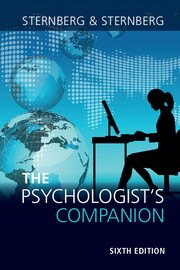 The Psychologist's Companion
The Psychologist's Companion Book contents
- Frontmatter
- Contents
- Preface
- Acknowledgments
- Introduction
- Part I Macro-Challenges in Writing Papers: Planning and Formulating Papers
- Part II Micro-Challenges in Writing Papers: Presenting Your Ideas in Writing
- Part III Writing and Preparing Articles for Journal Submission
- 11 Article Writing 101
- 12 How to Make Your Article even Better: Proofreading, Revising, and Editing
- 13 Critical Checklist before Submitting an Article for Publication
- 14 Deciding on a Journal and Submitting an Article to a Journal
- Part IV Presenting Yourself to Others
- Epilogue
- References
- Index
14 - Deciding on a Journal and Submitting an Article to a Journal
from Part III - Writing and Preparing Articles for Journal Submission
Published online by Cambridge University Press: 24 November 2016
- Frontmatter
- Contents
- Preface
- Acknowledgments
- Introduction
- Part I Macro-Challenges in Writing Papers: Planning and Formulating Papers
- Part II Micro-Challenges in Writing Papers: Presenting Your Ideas in Writing
- Part III Writing and Preparing Articles for Journal Submission
- 11 Article Writing 101
- 12 How to Make Your Article even Better: Proofreading, Revising, and Editing
- 13 Critical Checklist before Submitting an Article for Publication
- 14 Deciding on a Journal and Submitting an Article to a Journal
- Part IV Presenting Yourself to Others
- Epilogue
- References
- Index
Summary
If you write a paper that you believe makes a substantial contribution to psychological knowledge, you may want to consider submitting it for publication. This chapter will give you some information to help you decide on a journal. We will give you an overview of what you need to do to submit your paper and what goes on behind the scenes in an editor's office.
DECIDING ON A JOURNAL
If you decide to submit a paper for publication, the first step you must take is to decide on a journal to which you want to submit the paper. Ten considerations should enter into your decision:
1. Quality
Journals vary widely in quality. Some journals publish papers that do little more than fill up journal space; other journals publish only outstanding contributions to the literature. Better journals generally have higher rejection rates for submitted papers, so the probability of a paper's being accepted in such journals is lower.
One way to evaluate quality is to look at the impact factor of the journal. In Point 10, we describe how you can determine the journal's impact factor, or the extent to which papers in the journal are cited by authors in the field.
2. Content
All journals limit by content the kinds of papers they accept. Journal editors use either or both of two criteria in deciding on the appropriateness of a paper's content. The first criterion is substantive focus. What is the topic of research? The journal may accept, for example, only developmental, or cognitive, or applied papers. The second criterion is methodological focus. How was the research done? The journal may accept, for example, only experimental or theoretical or review papers. The journal lists we provide later in this chapter describe the content restrictions of many psychological journals.
3. Readership
Journals vary in (a) who reads them and in (b) how many people read them. Readership depends in turn on the quality and content of each journal and, to a lesser extent, on the cost of the journal. Journals publish annual statements of their circulation, so the extent of the readership can be determined by looking through recent back issues of a journal for the annual statement.
- Type
- Chapter
- Information
- The Psychologist's CompanionA Guide to Professional Success for Students, Teachers, and Researchers, pp. 280 - 292Publisher: Cambridge University PressPrint publication year: 2016


